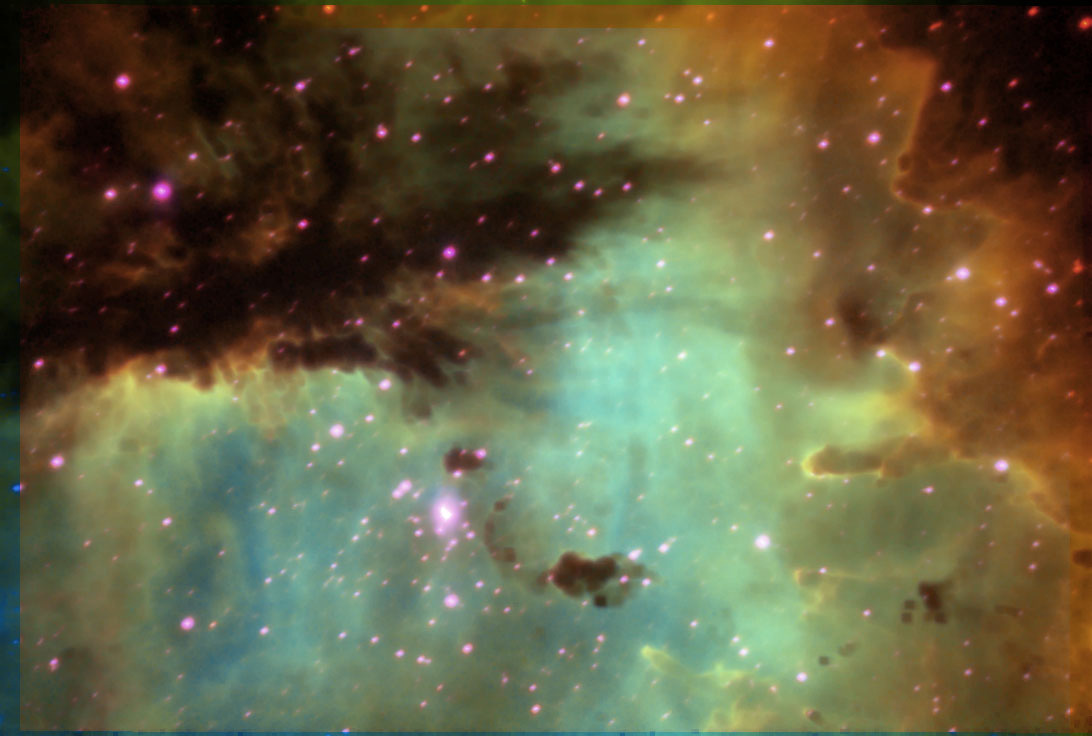NGC 281 - Pacman Nebula

NGC 281 - Pacman Nebula: Informally referred to as the Pacman Nebula for its resemblance to the video game character. NGC 281 is located in the constellation of Cassiopeia, and is also a part of the Perseus Spriral Arm. The Pacman Nebula is an HII region, which refers to low-density cloud of partially ionized gas where the formation of stars has recently taken place. NGC 281 is 18 arc minutes across (48 light years) and approximately 9,200 light years from earth. The nebula NGC 281 in the constellation of Cassiopeia was discovered in 1883 by E. E. Barnard, who described it as “a large faint nebula, very diffuse.”
Narrowband filters are useful in astrophotography by allowing the image taker to enhance the contrast of emitting objects by only accepting a small range of wavelengths around particular emission lines. Our group imaged NGC 281, the Pac Man Nebula, with three narrow band filters, H-a (656nm), OIII (501 nm), and SII (672 nm).
NGC: 281
Right Ascension: 0h 52m 48s
Declination: 56° 37' 0”
Apparent Magnitude: 7.0
Date: October 2012
Equipment:
Telescope: Meade 16" Schmidt Cassegrain with f6.3 reducer (used at ~ f6.1)
Camera: SBIG ST-10XE
Guiding: Starshoot autoguider; Meade 5"; PHD
Exposure:
Ha: 7x10 minutes binned 2x2
O(III): 4x10 minutes binned 2x2
S(I): 8x10 minutes binned 2x2
The camera was at -27°
Processing Notes: Images were captured CCDSoft, and reduced, and aligned using CCDstack. Subs were combined in Sigma Combine. Imported into Photoshop. Adjusted curves and levels. A minimum was applied to the stars to improve matchup. Individual channels were combined into a 3-color image and adjusted for aesthetics.
Scale: 1.06"/pixel
Links to images of this object on other sites:
http://calgary.rasc.ca/jm-ngc281.htm
http://www.caelumobservatory.com/obs/n281.html
Additional Comments: We used a monochrometer to measure the range of wavelengths allowed to pass through the filter. We found that the H-a filter had a full-width half-maximum intensity (FWHM) of 3.3nm centered around 656m. We found the OIII filter to have a FWHM of 6.7nm centered around 501nm. The SII filter had a FWHM of 6.4nm centered around 672nm. A plot showing fraction of total available light allowed to pass through the filter vs. wavelength for an H-a filter is displayed below.
This object can be appreciated with long exposure times such as those used in this image (10 min). The long exposure time caused some problems as it was periodically cloudy and PHD guiding was possibly set to correct too aggressively. This image is one of the first taken remotely from the onsite indoor facility.
Views: 11169
 This work is licensed under a Creative Commons Attribution-NonCommercial-ShareAlike 4.0 International License.
This work is licensed under a Creative Commons Attribution-NonCommercial-ShareAlike 4.0 International License.

